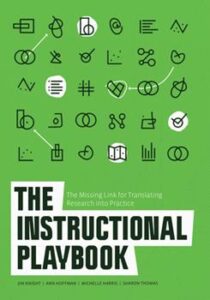Translating Research into Coaching Practice
The Instructional Playbook: The Missing Link for Translating Research into Practice
By Jim Knight, Ann Hoffman, Michelle Harris and Sharon Thomas
(ASCD, 2020 – Learn more)
Reviewed by Amy Tucker
At a time when there are unprecedented challenges in hiring qualified teachers, instructional coaches may be more important than ever.
The changing needs of students after disruptions resulting from the Covid-19 pandemic have added pressures to teachers to “accelerate learning” for all students, while also attempting to address social-emotional needs of disengaged students.
Tools and strategies that veteran teachers had taken for granted for decades may no longer meet the needs of an increasingly diverse and often needy student population.
Teachers who are new to the profession, including those from non-traditional pathways, may be eager to make a difference, but they also may lack strategies to manage classrooms, engage students, and communicate with caregivers. Instructional coaches can help fill that skills gap.
The target audience
The Instructional Playbook: The Missing Link for Translating Research into Practice supports district administration, Curriculum Coordinators, and Instructional Coaches in creating a flexible yet easy-to-follow guide to tackle current challenges in education.
This book – co-authored by one of the nation’s leading experts in coaching, Jim Knight – helps those who support teachers to work collaboratively with teachers to identify the areas that need the most improvement.
Based on local needs, coaches and other district personnel collaborate to determine the practices that research indicates will make the most difference. These are then compiled into a resource that coaches can use to quickly provide brief overviews and checklists to teachers, as they collaborate to improve teachers’ practice.
The Instructional Playbook describes the processes involved in building a team, defining areas of need, and determining which practices will be most likely to improve classroom outcomes. It includes research to support the recommended processes as well as explanations of why one strategy might be better than others.
The book’s structure
This book is organized into five chapters, the first explaining what an instructional playbook is and a rationale behind creating one. The next three chapters focus deeply on the different components of an instructional playbook: the table of contents, the one-pager, and checklists.
The last chapter contains resources that can be used to create district-level coaching playbooks. Each chapter follows the same structure: a visual learning map about key concepts, practical actions, a summary, reflection questions, and extension resources.
Selecting must-have strategies
The Instructional Playbook includes considerable discussion about the need for a small curated list of strategies and how to go about determining those that will have the greatest impact. There are suggestions about how a team could collaboratively narrow a wide range of strategies to those that will be most beneficial for the needs of teachers and students in a specific school or district.
If there are too many strategies to choose from, coaching becomes more challenging, and decisions about the most effective strategies to use become more difficult. Personally, when I am faced with too many options, I often become paralyzed, unable to make a choice until it is too late, and this is what the authors warn about.
This narrowed, curated list becomes the table of contents in a coaching instructional playbook. The authors recommend that this be limited to one page of strategies that will be included.
Much of the chapter about the table of contents discusses the recruitment of a diverse team to work together to determine common needs and goals of district teachers, categories with which to organize these goals, and strategies to improve achievement in each category. The authors remind readers that the playbook should be a living document, updated as district needs change.
As a “strategy hoarder,” I found this chapter really hard for me to read, because I know that sometimes, the perfect strategy for one group is not the one that works with every other group. However, I understand that the purpose of a playbook is for coaches to be able to have strategies that will be most likely to influence growth and positive change. And I don’t have to give up my favorites, even if they don’t make the cut!
Next steps
For each of the goals and strategies that make it to the table of contents, the next step is to create a one page overview that includes a brief summary, research that demonstrates effectiveness, rationales for using the strategy, and how the strategy is used by teachers and by students.
One-pagers are described as a communication tool between the coach and the teacher. They give enough information so that a teacher is able to determine whether a particular strategy might work, and their brevity allows this decision-making to happen in the course of a teacher’s busy day.
The Instructional Playbook also describes the key elements of supportive partnerships between coaches and teachers (a specialty of Jim Knight’s decades of research) and how a well-curated playbook can increase the trust and improve outcomes.
Checklists?!
I was a little leery of the last component of the playbook, checklists. Teaching is far too complex to reduce to simple checklists. The authors know this, however, and they do a nice job of explaining how this tool – done right – can help to streamline meaningful change. Knight and his colleagues encourage coaches to recognize that checklists cannot encompass everything, nor are they “one size fits all.”
I was pleasantly surprised to see the care and depth with which checklists were described, and the importance placed on maintaining the relationship between coach and teacher. Checklists are defined as comprehensive, concise, explicit, precise, and easy to understand. As a tool for learning new strategies, each checklist offers a concrete visual of the necessary steps involved.
Additional resources
The resource chapter contains several examples of each of the three components – the table of contents, the one-pager, and the checklists. There are some that seemed very sterile and data-driven, while others included components that reflected centering students’ social-emotional well-being (also supported by data!), with sections called
- “Emotional Tone: Practices that make students feel safe, valued, confident, and optimistic,”
- “Classroom Organization that make students feel honored, empowered, and included,” and
- “Instructional Practices that give students opportunities to take risks, explore, think deeply, and develop a sense of themselves as learners.”
I appreciate the different examples provided in an effort to show that different districts may approach an instructional playbook in ways that support the goals and focus of their community.
As a researcher, I appreciate the discussion and inclusion of qualitative research and naturalistic inquiry as potential supports of strategies for inclusion in a playbook. Though qualitative research is more context-dependent and less universally generalizable, it can open up more possibilities for new strategies in the classroom.
As a teacher and former instructional coach, I noticed a few places in the book that felt condescending toward teachers, although for the most part the authors emphasize that teachers must be the primary decision-makers in strategies they will use, and that coaches must listen to the concerns of teachers, rather than trying to impose their beliefs and strategies on them.
A timely resource
The Instructional Playbook: The Missing Link for Translating Research into Practice is a helpful resource, especially in a time when districts may have many new staff members and when traditional strategies no longer work for a population of students affected by disrupted learning during pandemic. With increasingly limited time in schools to support staff and students, a concise collection of concise strategies can facilitate deeper and more meaningful coaching conversations to improve the craft of teaching.
Amy Tucker (@aldtucker) is a middle school teacher and doctoral student. She is on the board of the Maine Association of Middle Level Educators. She is passionate about middle level education, integrated curriculum, equity, and critical media literacy. She lives and reads in rural Maine.


































